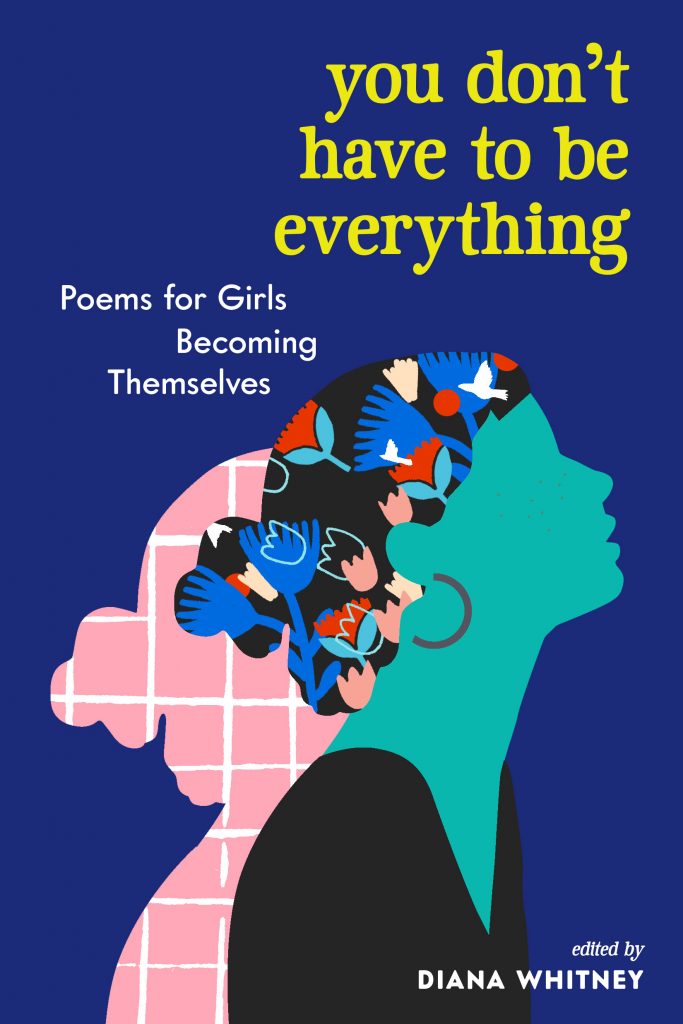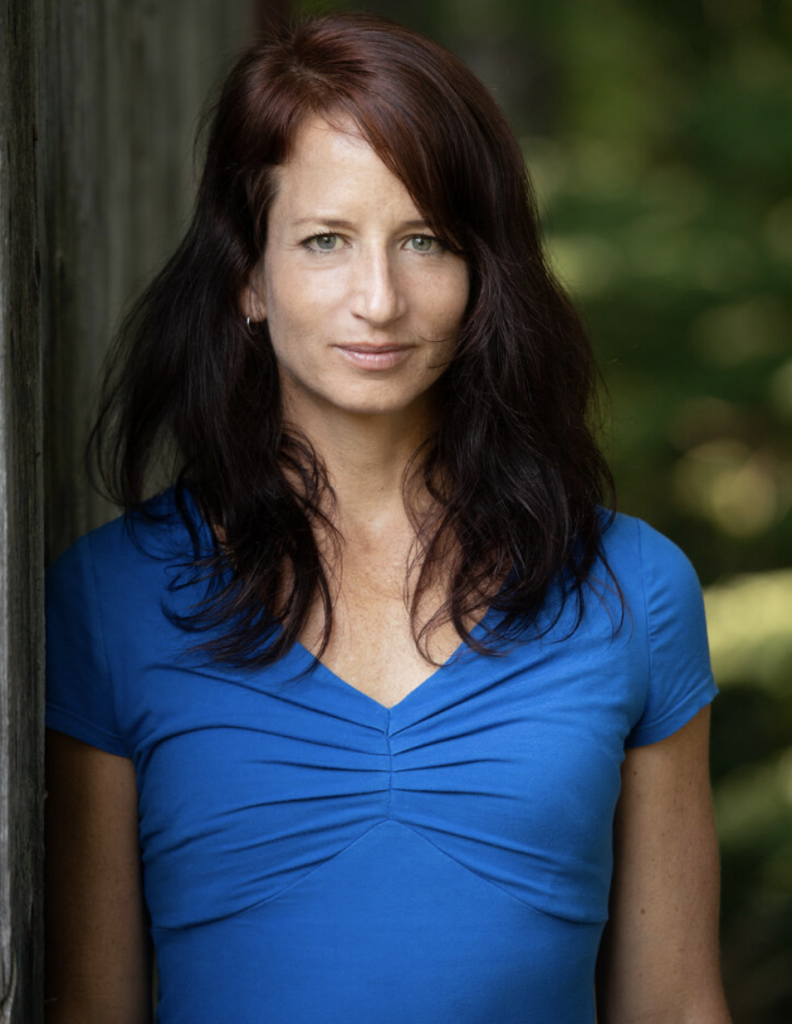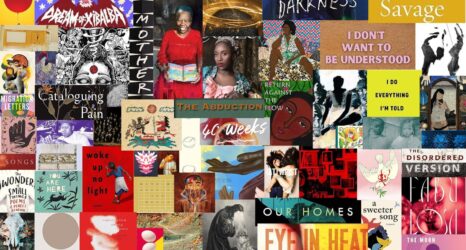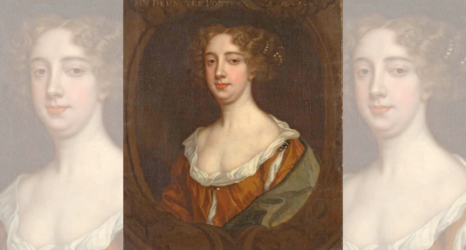
Editor, author, poet and queer mother of two Diana Whitney is making waves in the world of young adult poetry. Her new anthology, You Don’t Have to Be Everything (Workman Publishing), is in its second reprint and has been listed as #1 on the new release list for the Amazon teen/YA self-esteem.
The anthology features 68 intersectional and intergenerational voices across eight sections: Seeking, Loneliness, Attitude, Rage, Longing, Shame, Sadness and Belonging. Within a range of poetic styles and vibrant visuals, this collection features the work of Natalie Diaz; inaugural youth poet Amanda Gorman; Joy Harjo, U.S. poet laureate; Bianca Stone; Instagram stars like Nikita Gill; and many others.
Ms. writer Shanta Lee Gander recently talked with Diana Whitney about the ways this anthology encourages non-binary, trans and cis-gendered girls to bravely and boldly be themselves.

Shanta Lee Gander: How did this project find you?
Diana Whitney: In some ways, I’ve been working on it since I was 13, since poetry helped me to survive my adolescence. The literal project started two years ago when my agent and my editor at Workman Publishing came to me with the potential idea for a poetry anthology for teen girls. It became a seed within the soil of my own decades of experience, especially my time as a teen girl.
Gander: What was the process of how you approached the range of intersectional voices in the anthology? Did your thinking change over time?
Whitney: I spent over four years reviewing for the San Francisco Chronicle, so I’ve had this intensive immersion in deep thinking about contemporary poetry through my previous work. It was through that process that I was drawn to the voices of queer poets and a lot women poets of color. These were the poems that were speaking to me and the voices that I wanted to bring to readers. For me, the process of choosing poems or finding voices didn’t begin with the anthology—it’s almost like it had been evolving for years.
The original subtitle for this book was “Poems for Girls Becoming Women” and that evolved.
I always wanted to include trans and non-binary voices, for readers and youth who are questioning their gender identity. And I found some wonderful poems by trans women. Then I reached out to Cameron Awkward-Rich, a professor of gender and sexuality studies at UMass. I loved his book, Dispatch, and hoped to include his gorgeous poem “Meditations in an Emergency.” I was interested in his work as a fit for the anthology and a reflection of different experiences of “girlhood.”
Kindly, he told me he couldn’t be in a book titled “Poems for Girls Becoming Women.” He did the emotional labor of educating me, and I had to look at myself, my blind spots and my biases as a cisgender woman. It was a good learning experience. I asked if I could include the poem if I could get the language changed. Eventually, the title changed and I was able to circle back.
Other things shifted when I was in the throes of editing. I went on a residency in 2019 to the Virginia Center for the Creative Arts. I made a friend there who is a talented visual artist and also a disabled queer woman. She asked me, “Do you have disabled poets in your book?” I told her no and saw my own blind spots as an able-bodied person. Then I found this amazing anthology, Beauty is a Verb: The New Poetry of Disability. It opened my eyes to a lot of poets I hadn’t known. I chose Sheila Black’s poem, “What You Mourn,” for my anthology—but I wish I could have taken 10!
There were also other identities I wanted to include: Black voices, Latinx, Indigenous. These were really big questions because the constraints I faced were not about the quality of the poems. There was only so much room in the book—the original version was supposed to have only 50 poems. And I pushed that to 68.
As an editor, the other major constraint was budget. Certain “A-list” poems cost hundreds of dollars each, and unfortunately I had to choose what I could afford.
Gander: What makes this anthology so unique is the way that a reader sees you engaging with the work as the younger self who wishes she had had this advice. Can you speak more to this?
Whitney: It’s sometimes hard to go back and remember who you were at 14, 15 or 16, but with these poems, I could easily do that. They were a bridge that allowed me to step onto the page and have a conversation with them.
The poem “Practicing” by Marie Howe evoked my very first relationship back in 7th grade—a secret relationship with another girl. When I encountered it in my 20’s, the poem spoke to me because I’d been in the closet as a queer person during high school. I felt seen by that poem.
While I was working on the anthology, I kept imagining my teen self encountering that poem and being given permission. It was cathartic to read other poems that way, like Dominique Christina’s “The Period Poem,” which is a fierce indictment of misogyny. The rage in those lines is an energy force. I thought about my teenage self—who was so ashamed of her period—and remembered the different slurs for menstruation I heard in the 80s. Reading that poem then would’ve felt freeing.
Gander: We do not give permission for girls and women to express rage, especially girls and women who are in brown bodies. As a former sexuality educator, I also find that people are uncomfortable with the sexuality of teen girls. What are your thoughts about this in relationship to the collection?
Whitney: On the one hand, our culture basically sells the sexuality of teen girls. The term “teen” is one of the top search terms in hardcore porn, so girls’ bodies are commodified. They’re used to sell everything from internet porn to clothing and skincare.
At the same time, we’re deeply uncomfortable with any sort of empowered, authentic expression of desire from those bodies and those voices. They’re often vilified for expressing desire.
I was a teen girl who had a lot of desire and curiosity about sexuality and I didn’t want to pathologize that in this anthology. I wanted to show that these feelings are normal, healthy, natural experiences of being a teenager. I wanted to show that desire can be a source of joy, but also a source of agony.
Going back to the question of rage, especially as a Gen X woman, there is more permission now to express rage. It feels different from how we were raised to be nice, appropriate and not make people uncomfortable. It’s even more unacceptable for Black and Brown voices to express rage, it’s considered even more threatening.
The expression of rage is a natural response to living under the systems of patriarchy and white supremacy. I love the poem “On Anger” by Rage Hezekiah, how she specifically addresses this theme. There are also poems about silence breaking—taboos, history, sexual violence and trauma—in the anthology’s Rage chapter.
As parents in this culture, there is our general discomfort regarding female sexuality. There is a natural impulse to protect our girls. As an editor and a mother of two daughters, I know firsthand what their world is like.
Gander: As a queer mother of two, can you speak about how you saw your range of identities in this project?
Whitney: My awareness of my girls and what they’ve been through since hitting puberty was instrumental to this anthology. In terms of their world, my girls have survived some serious trauma and struggle ranging from depression, anxiety and suicidal ideation, to vicious cyber-bullying and sexual violence.
For anyone who might have concerns that this anthology is too “mature,” I would tell them what my 12-year old is coming home and telling me is happening in 7th grade. I would also tell any parent to read Peggy Orenstein’s Girls and Sex—she is an amazing journalist and her work on young people and sexuality has been invaluable to me.
Young adults are learning their edges around their relationships, and unfortunately, what they learn about intimacy and consent often comes from the internet and from porn culture, which is deeply disturbing. When my girls were in elementary school, a 6th-grade boy sent an unsolicited dick pic to a 6th-grade girl. These kids have powerful technology in their pockets. This is not a fear-mongering-mom-thing, but the reality of our digital world.
The voices in You Don’t Have to Be Everything explore the narrative of desire and empowered sexuality. The poems also show humanity, pleasure, and love.
Gander: Why is this anthology key for this moment? Why does it matter to young adults and the rest of us?
Whitney: Is it okay to claim that this project does have an intersectional feminist mission? Of course, this doesn’t mean that there aren’t some gaps.
In some ways, the collection is deeply personal, featuring the poems I wish I’d read when I was a teen. If there was some ideal intersectional feminist anthology, it probably would be broader and longer. But it was important for me that this book not be too big. Digital natives are reading bite-sized content on phone screens, so I knew having a huge tome of a poetry book would not be accessible.
Poetry is having a moment right now, and I hope it’s not just a moment. We turn to poetry in times of emotional need, and in times of collective crisis. There’s been a phenomenon of people sharing poems online, and certain poems have gone viral. People are sharing poems that speak to them deeply while saying what feels unsayable. I believe poetry has become a necessary genre, and this book can connect with teen readers and with older readers. There are many of these poems that you could encounter for the first time as an adult, and hopefully, they would still speak to you.
The collection is a mix. It includes a handful of celebrated Instagram poets, which was a deliberate choice. These are poets who have used the internet to find an audience, and already have a beloved following. I see this as a marvelous democratization of poetry which has happened online.
Gander: If you encountered someone in the future who read the anthology, what would be your hope for that interaction?
Whitney: It’s even hard to go there. I’m thrilled that there have been early positive reviews, but it almost feels like jinxing it.
I will speak to a specific imagining. I just heard from a woman who’s teaching a youth workshop on queer love poetry through a program in Tennessee called “Write with Pride.” I shared an early copy of the book with her and mentioned the one-third of poets LGBTQ+ in the book. I’d like to imagine her students reading queer poems of desire like Rachel Wiley’s “But They Say I Will Not Make It.” I want to imagine their eyes getting wide, or maybe laughing a little. Perhaps one of these poems makes them feel seen, or gives them the feeling of their world expanding.
My wildest hopes are that the grandmas who buy this book love it as much as the young people they give it to. Or perhaps there are trans or non-binary youth who will read “Flowers #3″—a poem of self-love and self-acceptance by Joshua Jennifer Espinoza—and then learn about her story. Maybe they will feel seen, connected, and get this sense that, ‘I can be who I am. I can grow into who I am. I’m worthy of love, I can have these thorny, difficult feelings. I can have wild mood swings and be full of rage, I can be horny. I can be sad. It’s all part of the spectrum of human experience.’
You may also like:





